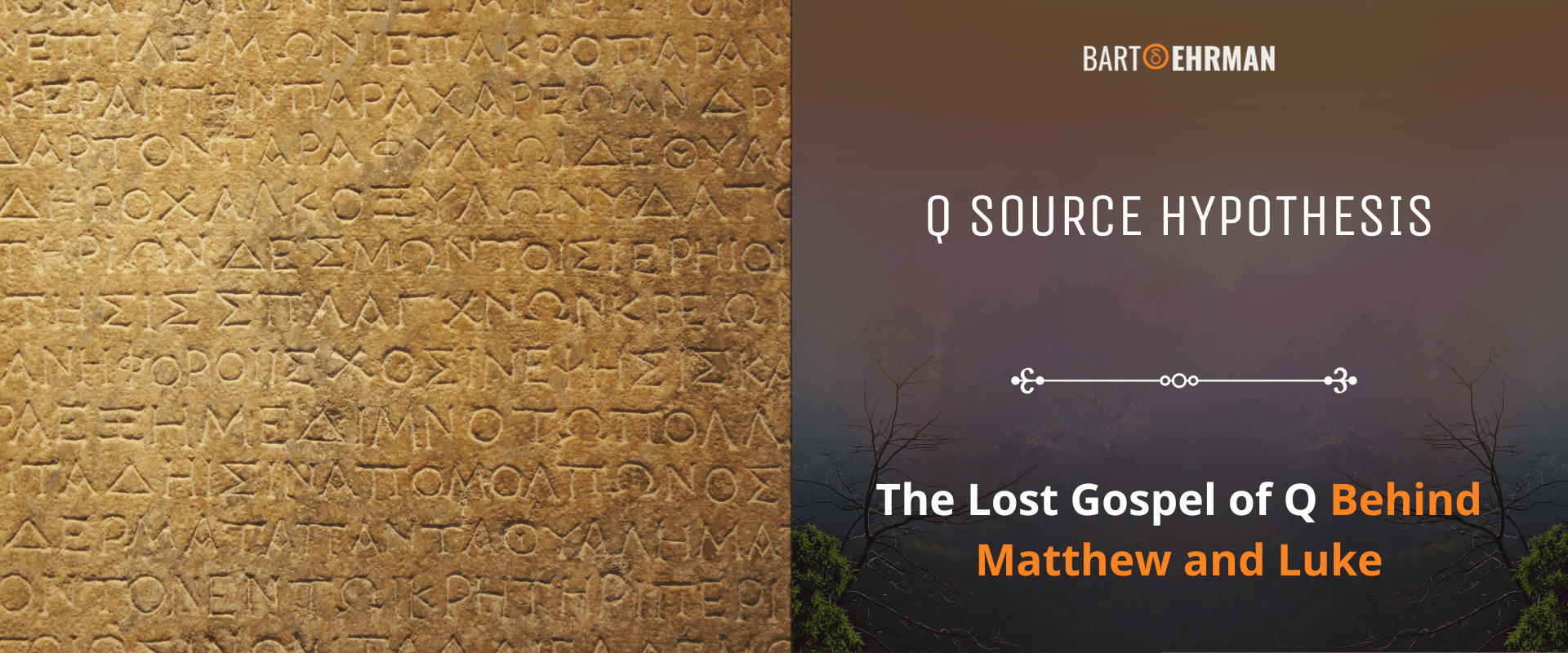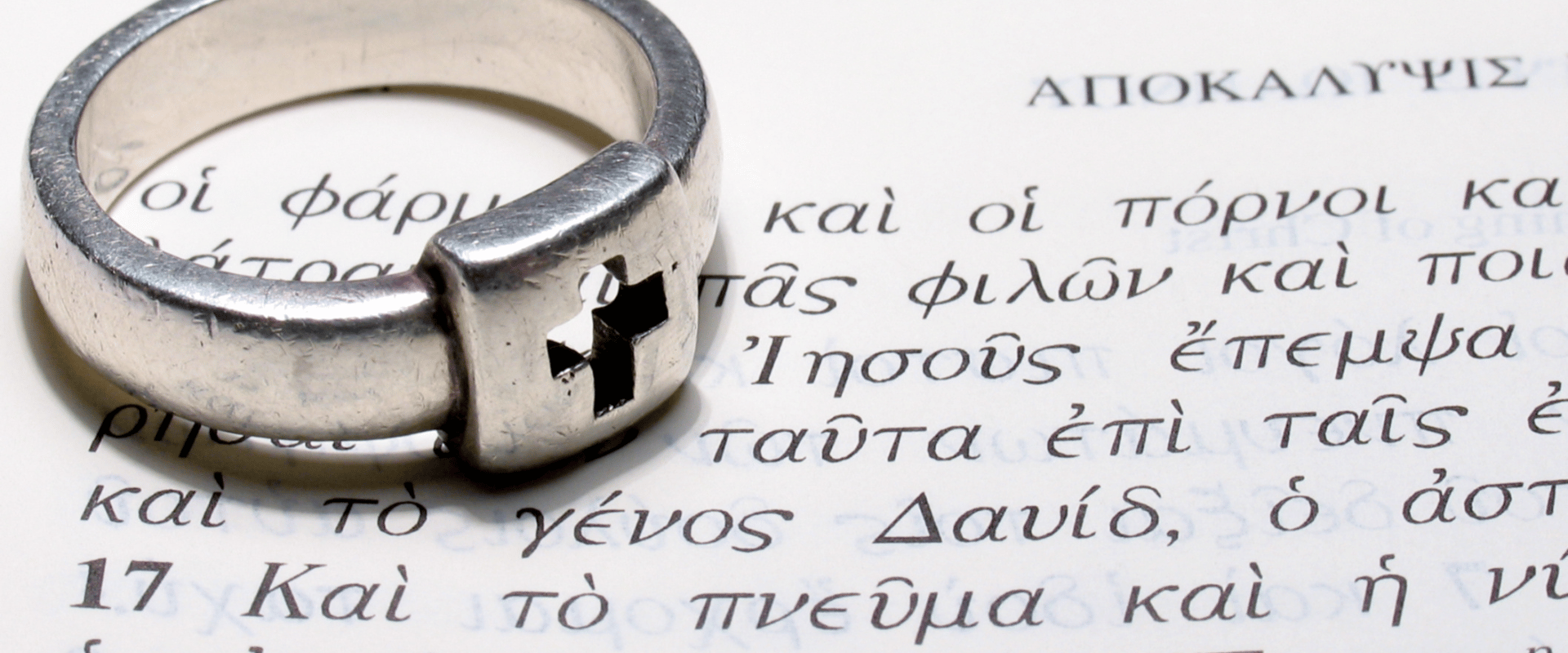Q Source Hypothesis: The Lost Gospel of Q Behind Matthew and Luke

Written by Joshua Schachterle, Ph.D
Author | Professor | Scholar
Author | Professor | BE Contributor
Verified! See our editorial guidelines
Verified! See our guidelines
Edited by Laura Robinson, Ph.D.
Date written: September 8th, 2023
Disclaimer: The views and opinions expressed in this article belong to the author and do not necessarily match my own. - Dr. Bart D. Ehrman
In looking at the origins of the Gospels, we have to address the Q source hypothesis. This is a theory about one of the possible sources for the written material in the Gospels. Scholars have used this theory to explain what is called the Synoptic Problem. Let’s start by defining that problem.

The Synoptic Problem
Scholars call Matthew, Mark, and Luke the Synoptic Gospels. The word synoptic is derived from a Greek word meaning “seen together.” In many instances, you can put passages from all three of these Gospels side by side and they are virtually identical. That is, they can be “seen together.” Look at this example:
Matthew 3:16-17 | Mark 1:10-11 | Luke 3:21-22 |
|---|---|---|
16 And when Jesus had been baptized, just as he came up from the water, suddenly the heavens were opened to him and he saw God’s Spirit descending like a dove and alighting on him. 17 And a voice from the heavens said, “This is my Son, the Beloved, with whom I am well pleased.” | 10 And just as he was coming up out of the water, he saw the heavens torn apart and the Spirit descending like a dove upon him. 11 And a voice came from the heavens, “You are my Son, the Beloved; with you I am well pleased.” | 21 Now when all the people were baptized and when Jesus also had been baptized and was praying, the heaven was opened, 22 and the Holy Spirit descended upon him in bodily form like a dove. And a voice came from heaven, “You are my Son, the Beloved; with you I am well pleased.” |
Not only are the stories the same, but the language is almost identical. We can define the Synoptic Problem, then, as the question of how this came to be. Were all these Gospels drawing from the same source? Or, alternatively, were two of them drawing from the third?
Since the 19th century, biblical scholars have known that Mark was our earliest written Gospel (this is called Marcan Priority). It was written around the year 70 CE. Matthew and Luke, however, were written at least 10 years later between 80-95 CE.
Given this information, it becomes clear that Matthew and Luke took a lot of their material directly from Mark. In fact, they probably had written copies of Mark in front of them while they were writing. Otherwise, how could they have used not only the same stories but also the same language?
While this answers a lot of questions about the relationship between the Synoptic Gospels, there is more to the mystery. It turns out that Matthew and Luke share some material not found in Mark. This is where the Q Source Hypothesis comes in. Scholars have long assumed that in addition to Mark, Matthew and Luke relied on a second source for their Gospels which they have called the Q source. So what is the Q document?
The Q Source Hypothesis and its History
The Q source – I’ll refer to it as Q – is named for the German word Quelle meaning “source.” It was conceived of as an explanation of the material shared by Matthew and Luke but not Mark. Richard Valantasis notes that Q likely began as a set of oral traditions that were later written down. Again, this is only a hypothesis since no actual copies of Q survive.
Throughout history, people have theorized about a second source for Matthew and Luke. The commonly-held view of this document was put forth by B.H. Streeter. Streeter believed that Q was written in Greek. He also believed that its material appears in both Matthew and Luke.
Another aspect to this theory comes from a statement by an early Christian author named Papias of Hierapolis. Writing in the late 1st or early 2nd century, Papias wrote that “Matthew compiled the sayings of the Lord in a Hebrew manner of speech, and everyone translated them as well he could.”
As I said above, scholars believe that the Q sayings were originally written in Greek. Nevertheless, Papias’ statement seemed to confirm that there was a written source consisting of sayings of Jesus. As it happens, most of the Q material consists of sayings rather than stories.
FREE COURSE!
WHY I AM NOT A CHRISTIAN
Raw, honest, and enlightening. Bart's story of why he deconverted from the Christian faith.
Over 6,000 enrolled!
When Was Q Written?
Since Matthew and Luke apparently made use of Q, it must have been available prior to their time of 80-95 CE. John Kloppenborg speculates that Q may have been formed in the 40s or 50s CE. If so, it predates even Mark, our earliest written Gospel.
Contents of Q
Q consists mostly of sayings attributed to Jesus. If its dates are as early as some scholars believe, the earliest level of Jesus traditions are sayings rather than stories. Although we don’t have any copies of Q, scholars have reconstructed it by taking material shared by Luke and Matthew but absent in Mark.
This includes well-known passages like the three temptations of Jesus by the devil, the Lord's Prayer, and the Beatitudes. Let’s look at some of these sayings, starting with the Beatitudes.
“Blessed are you who are poor, for yours is the kingdom of God.”
“Blessed are you who are hungry now, for you will be filled.”
“Blessed are you who weep now, for you will laugh.”
There are also individual sayings, sometimes contextualized like this:
As they were going along the road, someone said to him, "I will follow you wherever you go." And Jesus said to him, "Foxes have holes, and birds of the air have nests; but the Son of Man has nowhere to lay his head." To another he said, "Follow me." But he said, "Lord, first let me go and bury my father." But Jesus said to him, "Let the dead bury their own dead; but as for you, go and proclaim the kingdom of God."
There is no way to be certain that these sayings actually go back to the historical Jesus. However, scholars like Kloppenborg believe there is a good possibility Q sayings could be authentic.
What is also interesting about Q, though, is what it doesn’t contain.
What Does Q Leave Out?
Q doesn’t contain many of the significant events of Jesus’ life found in Mark. Instead, it focuses almost entirely on what Jesus said. This means that it leaves out a lot of material considered essential to Christianity. It doesn’t talk about Jesus’ birth, first of all, but there’s an even more surprising omission.
Q never mentions the crucifixion!
Our earliest Christian sources, Paul’s letters and Mark, consider the crucifixion essential to their theology. Nevertheless, Q doesn’t speak of the crucifixion at all. There could be several explanations for this. While Mark and Paul emphasized the crucifixion, the Q source tradition may have emphasized Jesus’ wisdom instead. Perhaps Q even represents an early form of Christianity for whom the crucifixion wasn’t important.
By the way, since Q doesn’t talk about the crucifixion, it also doesn’t mention Jesus’ resurrection.
There are other early Christian documents - one called the Didache, for example – which also don’t mention Jesus’ crucifixion or resurrection. This shows the intriguing diversity of early Christianity of which many modern people are unaware.

Elephant in the Room: Where is the Q Document?
The thing we haven’t yet mentioned, but which we can’t ignore is this: if Q existed, why don’t any copies survive? We have copies of all four gospels, the letters of Paul, and many other early Christian documents. Where is Q?
First of all, there are many lost early Christian texts. We only know of these texts because other ancient authors cite them or mention them in surviving texts. In addition, perhaps after Q had been written into Matthew and Luke, Christians no longer thought they needed it.
Either way, the Q Source Hypothesis remains one viable explanation for the non-Marcan material shared by Matthew and Luke.
Conclusion
In exploring the Q source hypothesis, we've probed the intricate world of Gospel origins and the enigma of the Synoptic Problem. While the physical existence of the Q document remains speculative, its hypothetical influence on Matthew and Luke fuels ongoing scholarly debates.
The Synoptic Problem, centering on the parallel narratives of Matthew, Mark, and Luke, continues to captivate scholars. Q, if real, would shed light on the transmission of Jesus' sayings, yet its omission of crucifixion and resurrection narratives adds complexity to early Christian thought.
FREE COURSE!
WHY I AM NOT A CHRISTIAN
Raw, honest, and enlightening. Bart's story of why he deconverted from the Christian faith.
Over 6,000 enrolled!
